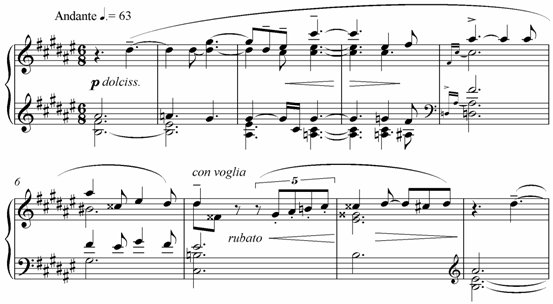
BPM home | Volume 7 index | Article
Feeling that the drudgery of teaching work had stifled the talents of a creative genius, Scriabin left his post at the Moscow Conservatoire in 1903, devoting himself entirely to composition. Many ideas that had been gestating during this time grew into some of his finest compositions, yielding a surge of music often referred to as his 'middle period'. It was during this time that Scriabin's music and philosophy became preoccupied with the mystical and the erotic. The aims of this brief paper are (1) to explore how Scriabin developed a rich musical symbolism to depict certain types of erotic encounter; (2) to explore the significance of predecessors such as Wagner to the development of this symbolism; (3) to define ways in which this language characterises masculine and feminine elements in an attempt to portray idealised erotic experience and (4) to examine issues of gender polarity in view of Scriabin's philosophy of artistic creation.2
Particularly reflective of this 'middle period' is the Fourth Sonata in F# Major, op.30. The music is complemented by an unpublished example of Scriabin's linguistically over-charged poetry, in which a superhuman, god-like being is enticed by a distant star which he flies towards and blissfully engulfs. The two movements follow the poem's teleological form in one of Scriabin's earliest attempts to create a state of ecstasy, symbolised by 'flight'.
In a light mist, transparent vapour
Lost afar and yet distinct
A star gleams softly.How beautiful! The bluish mystery
Of her glow
beckons me, cradles me.O bring me to thee, far distant star!
Bathe me in trembling rays
Sweet light!Sharp desire, voluptuous and crazed yet sweet
Endlessly with no other goal than longing
I would desire.But no! I vault in joyous leap
Freely I take wingMad dance, godlike play!
Intoxicating shining one!It is toward thee, adored star
My flight guides meToward thee, created freely for me
To serve the end
My flight of liberation!In this play
Sheer caprice
In moments I forget thee
In the maelstrom that carries me
I veer from thy glimmering raysIn the insanity of desire
thou fadest
O distant goalBut ever thou shinest
As I forever desire thee!Thou expandest, star!
Now thou art a Sun
Flamboyant Sun! Sun of Triumph!Approaching thee by my desire for thee
I lave myself in thy changing waves
O joyous godI swallow thee
Sea of lightMy self-of light
I engulf Thee!3
There was a tendency among Scriabin's circle of poets, artists and musicians to bifurcate their philosophical and aesthetic ideas into polarities of gender. Boris de Schloezer, professor of philosophy, close friend and biographer of Scriabin, gives us a taxonomy of mystics in his book Scriabin: Artist and Mystic. He says, "If we draw our categories according to the relationship between the mystic and the Unique, it is possible to posit two types of mystical experience, passive and active, feminine and masculine."4 He classified the thirteenth-century mystics Meister Eckhart and St. Angela of Foligno as feminine; these people extinguished their will-power in trance-like states, epitomised by Mme. Guyon in eighteenth-century France who came close to death in such a state of passivity. We could add Scriabin's revered Helena Petrovna Blavatsky to this list of course; she believed herself to be writing her Theosophical landmark The Secret Doctrine under telepathic instruction from her masters in Tibet.5 The masculine type of mystic was very rare; Schloezer names only Jakob Böhme, describing him as an "active" and "virile" force. One of Scriabin's own pronouncements in his notebooks will help us to see where he placed himself in this dichotomy: "I want to swallow all and include (all) in my individuality. I want to give (to the world) pleasure. I want to seize the world as [one would seize] a woman."6 Scriabin was to be a masculine, all-consuming, dominant, life-giving force.
The masculine and feminine principles, which Scriabin regarded as 'active' and 'passive', are the subjects of an intimate musical drama. Taking our cue from Scriabin's poetry we find that gender is unveiled when the object – the 'distant star'– is referred to as 'her' and thus feminised. It is fairly safe to assume, given Scriabin's frequent pronouncements about the concept of 'flight' and his real-life flying experiments, that the poetic subject is masculine and no less a being than himself.7 The opening bars of music embody the kernel of this gender polarity where two voices are synchronically revealed, both moving in contrary directions to create a beautiful impression of blossoming sound.8

Example 1
Each of these voices contains characteristics of gender representation which were prevalent in the nineteenth century. The first sonority we hear in the left-hand is essentially a B 'major 7th' chord, the outer parts containing the interval of the seventh. A parallel chromatic descent begins which lasts throughout the first four bars.

Example 2
Susan McClary argued that the descending chromatic line is a common trope for female seduction in nineteenth-century opera to the extent that in Bizet's Carmen, Carmen's voice is confined to this kind of melody. Feminine control is displayed through the rate of chromatic descent and Carmen playfully lingers over certain pitches in order to draw attention to her control.9 Some commentators have found elements of chromaticism in the voice of the seductive sirens in Wagner's Tannhäuser, and the influence of Wagner was certainly strongly felt to Scriabin in 1903. Looking closer at Tannhäuser we find that Venus herself becomes chromatic when Tannhäuser tries to break free. In actual fact it is the orchestral voice which becomes chromatic, imitating the bodily gestures behind Venus' purely diatonic and authoritative melody. We notice this most strongly in the music that accompanies Wagner's stage direction, "Venus, covering her face with her hands, turns passionately away from Tannhäuser, after a pause she turns to him again smiling, and with a seductive air."10

Example 3
Using the same tremolandi that later portray the stars in Wolfram's Act III prayer 'Da scheinest du, O! lieblichster der Sterne', Venus uses chromaticism as a tool to regain some semblance of control. In the Fourth Sonata this descending chromatic line corresponds to the poetic subject (undoubtedly Scriabin himself) who yearns for the star to beckon him – he wants to be seduced.
But this chromatic sound-object is heard underneath a rising series of fourths in the upper voice, moving from D# through G# and C# to a displaced F#.

Example 4
This assertive, powerful, strident sequence of fourths, associated with the world of military trumpet calls, has shown the manliness of many an operatic hero, particularly Wagner's Siegfried, a character who is often cited as the influence to Scriabin's early plans for an opera. Siegfried's debut as a protagonist in The Ring is fairly typical:

Example 5
These fourths, played with anacruses, are found as recurring motives throughout Scriabin's career. Ellon Carpenter finds many variants of the following figure in the Third Sonata, op.23.11

Example 6
Observe how this figure rises boldly with a fourth and then descends chromatically. And this pattern finds other voices, most famously in the Poem of Ecstasy, op. 54, commonly known as the trumpet's "I am" motive.12

Example 7
In the Poem of Ecstasy it famously represents the assertion of the ego – a masculine, creative ego amid a passive universe. The motive microcosmically contains much of the discourse of Scriabin's music; the masculine trumpet-call reaches out of the music's surface and becomes dissolved back into it through a chromatic fall. This offers a pattern of assertion followed by retraction, or attempt followed by failure; these patterns expand into phrase structures everywhere, particularly in the following presto volando movement. Here the first two bars are transposed upwards by a fourth and followed by a chromatic ascent until this melodic rise dissipates and we are drawn back down to our starting point of D#.
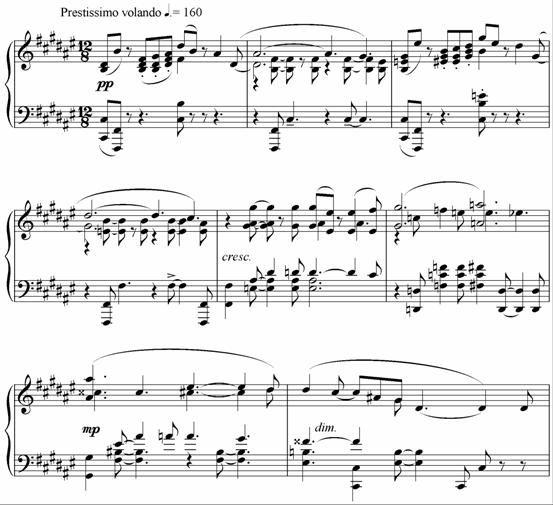
Example 8
The cumulative affect of phrases such as this, where tension is generated and then mildly dissipated, work within a sonata form to produce a special kind of forward momentum in which, as Stephen Downes puts it, "the sonata design is subsumed or overwhelmed by a single climactic trajectory towards a final cataclysmic revelation".13 I can find no better way of illustrating Scriabin's structure than with some of Wilhelm Reich's diagrams from The Function of the Orgasm, showing the 'Forepleasure mechanism' and the 'End-pleasure mechanism'; only in the latter "is the energy discharge equal to the accumulated tension".14

Figure 1
Each temporary set-back to the persistent god-like subject increases his desire to reach a state of orgasm – which Scriabin predictably explores at the very close of the work.
Looking back to the "I am" motive from the Poem of Ecstasy we find the fourths balanced along the temporal axis through the chromatic fall which immediately follows.
| Rising fourths | Chromatic Fall |
But in the opening of the Fourth Sonata the fourths continue their trajectory and balance is restored contrapuntally by the descending chromatic voice. The two paradigms are spatially superimposed.
| Rising Fourths |
| Chromatic Fall |
Bar 6 of this sonata displays yet another operatic gesture when over a gentle, lulling rhythm, parallel sixths are heard which discharge the tension of the sevenths in the opening chords.
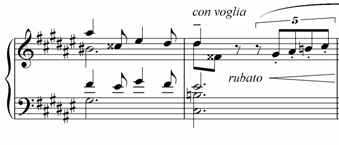
Example 9
Singing in sixths or thirds is a well-known symbol of the union of characters in the operatic tradition. Scriabin's favourite opera Tristan and Isolde appears to be a poor model here because, when the characters initially drink the love potion, most of the subsequent discourse in Act I occurs in pure octaves. But we may be able claim that this is just 'the drink talking' here as most of their Act II discourse utilises many parallel thirds and sixths at moments of particular closeness.
In bar 6 this 'coming together' of the two voices seems to be complete. The lower chromatic voice has tamed the upward thrust of the rising fourths and pulled the F# downwards to create the octave displacement – thus we feel satisfaction. But we are only allowed to enjoy this harmonic union for one bar. The dominant seventh on G# (II7) which underpins the gesture, resolves to a C# seventh chord (V7) for a mere quaver beat before an obtrusive 'wrong note' throws a spanner in the works – an Fx marked 'con voglia'. This 'wrong note' comes from the expectation that the upper D# (6) would resolve naturally as a suspension to a C# (5), and this drop of a minor sixth comes as something of an interruption. This 'dropping' figure becomes a salient motive at the ends of phrases throughout the sonata. It always appears at moments where the voices fail to unite and where the expected tonal resolution is taken to new harmonic areas. Perhaps this is another gesture from opera, where a decisive statement, often of rejection, is supported by a melodic drop. In Tristan we find this everywhere, particularly in the many instances where Tristan and Isolde repeat each other's names in a desperate bid to unite, but the repetition only serves to highlight their individuality. This example from the end of Act I is particularly representative.
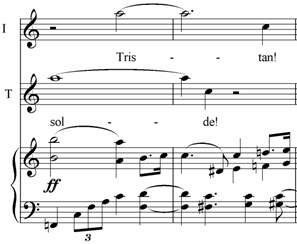
Example 10
We find a similar pattern in the love scene from Siegfried. Just before Brünnhilde sings her beautiful 'Ewig war ich, ewig bin ich' she begins to show signs of doubt and turmoil.

Example 11
The melodic drop in the Sonata falls from the note D# (6), simultaneously prolonging the pitch from the first bar and reducing the voice of rising fourths to its starting point – square one. Indeed the voice immediately uses a simple scale to reemphasise this 6 through an appoggiatura in a Tristanesque 'longing' motive.

Example 12
The 'Tristan chord' here is well placed as Scriabin's poem refers to the subject having "no other goal than longing" – the desire to desire. Scriabin undoubtedly mused upon the concept of desire leading only to renewed desire in his youthful readings of Schopenhauer and obviously felt the resonance with Wagner.
In bar 19 of the sonata Scriabin launches into a section which develops this 'longing motive' in many different keys. He generally seems to interpret the Tristan chord as a French sixth, accented with an appoggiatura. This resolves to the dominant and thus indicates the tonic only through implication. In this way Wagner's opening to Tristan presents the key of A minor through use of a French sixth moving to a dominant seventh without actually presenting a specific tonic chord. The tonic is the absent goal.

Example 13
And this is how tonality is made implicit in the Fourth Sonata. Scriabin exploits many key relationships of varying stability; in fact he indicates no less than ten different keys throughout the movement without ever giving a definitive cadence. Moreover these French sixth chords frequently present the dominant onto which they resolve as if it were satisfaction in itself without the need for a tonic, thus destabilising the functions of tonic and dominant.
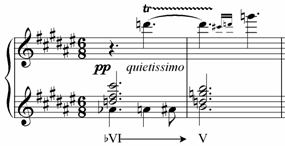
Example 14
In this example the trill, which is usually an embellishment of a dominant chord, actually appears over the French sixth and makes this feel like a chromatic move to G major rather than to C major. Tension is only partially discharged – in line with Reich's 'Forepleasure mechanism'. These pseudo-cadences occur in many different and distantly related keys, always searching for a tonal object of satisfaction, finding only transitory moments of gratification. The only cadence per se is given to us at bar 14 in the key of B flat. On reemphasis of this local tonic at bar 16 however, the melodic material from the 'union of sixths' is now presented in an incomplete form – as a single monodic voice. This monodic voice soon descends from its serene, angelic heights and becomes chromatic, once more leading us to the characteristic negation of the dropping sixth. This time the sixth is intensified with cross-rhythms in the lower parts – a further separation.
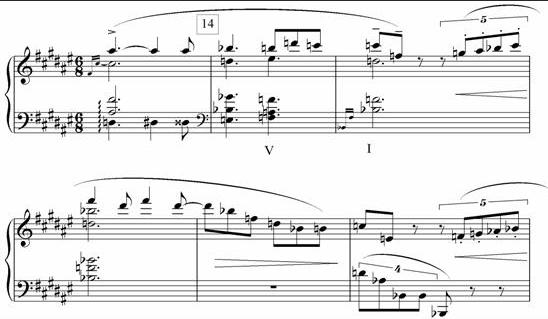
Example 15
If we have any doubts about the separation of the musical material into an active / passive dichotomy in the early bars, which were tinged with an atmosphere of "light mist" and "transparent vapor", then more concrete evidence can be found in the repetitions of the opening period structure. At bar 35 there is an interchange of voices where the left-hand of the pianist brings out the rising fourths whilst the right-hand plays a more objectified version of our 'siren song' with the chromatic object moving in octaves. This presentation provides support to the image of the "distant star" which "twinkles softly" being played pianissimo in the high register with "glimmering rays".
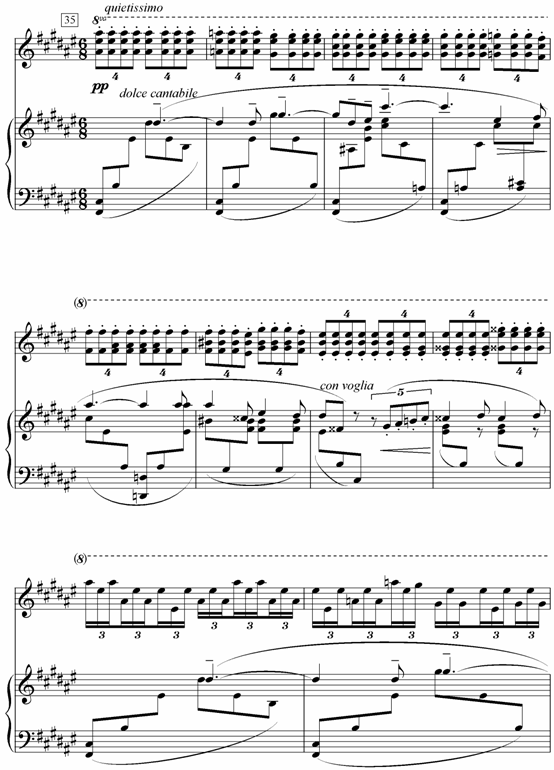
Example 16
Separation between the voices is emphasized in two newer ways. Firstly, the piano is spatially inverted. The masculine fourths are now in the lower 'earthy' register and are constantly trying to penetrate the distant material in the right hand which is now much higher. At times the hands come close together and, when the fourths are articulated, they almost touch each other as if the musical drama is now being enacted in the physical gestures of the pianist. Secondly, the two voices become rhythmically disjointed; the lower articulates the triple metre while the upper presents a cross-rhythm in groups of four, adding a further layer of separation to the voices.
We have read the poem which was written to accompany the sonata and have heard the story of the man trying to fly to and have union with a distant star, but let us look at these opening measures from a different angle. In 1903 Scriabin was about to lapse into solipsism under the influence of the psychologist Wilhelm Wundt and philosopher Johann Fichte who saw the mind as the absolute principle of reality. As is well known, Scriabin came to believe that the physical world was a mere representation of his own psyche, and he was therefore the creator of the world. As early as 1894 his notebooks show a firm belief that creation is the key to salvation: "I can say that they [people] can expect nothing from life except THAT WHICH THEY CREATE BY THEMSELVES ALONE".15 And in 1904 his notebooks read "Thus, it is that I am the author of all experiences. I am the creator of the world ..."16 Scriabin's initiation to Philosophy came in 1894 through Schopenhauer's World as Will and Idea. Of course Scriabin did not feel any sense of responsibility to apply Schopenhauer in the same pessimistic context. Scriabin felt that by imposing his will rather than the will, he was 'overcoming himself' in a Nietzschean sense. He synthesised these ideas to predict a highly optimistic end when he would lead the world to apocalyptic ecstasy with his eschatological Mysterium – a final satisfaction of the will where the suffering of desire would be laid to rest.17
The act of creation was equated with eroticism to Scriabin; Leonid Sabaneeff records the following conversation.
the creative act is inextricably linked to the sexual act. I definitely know that the creative urge in myself has all the signs of a sexual stimulation within me ... And note please that the creative artist is square in the middle of this – the weaker he [the composer] is in the sexual area, the weaker his art. Maximum creativity; maximum eroticism. Look at Wagner. Tristan is his maximum, and Parsifal, already it has dropped. It's the work of a worn out old man.18
This link between creation and the sexual impulse no doubt comes from Scriabin's early reading of Schopenhauer. In Schopenhauer's words:
The sexual impulse proves itself the decided and strongest affirmation of life also that to man in a state of nature, as to the animals, it is the ultimate purpose, the highest goal of life ... Consequently the genitals are properly the focus of the will ... As such they were revered among the Greeks in the phallus, and among the Hindus in the lingham, which are thus the symbol of the affirmation of the will.19
Of course to Schopenhauer, music was a manifestation of the will itself. But Scriabin also discussed the process of creation as gender-polarised discourse.
The spirit (the creative principle) is conscious of a polarity of the masculine and feminine elements, the one active, the other passive, the will and resistance. The latter element, inactive and inert, becomes crystallised in the immobility of the material forms, in the World with its manifold phenomena.20
He then describes how these poles initially separate but reach "a culminating point" where they feel a need to unite that he calls "dematerialization" and "synthesis". Material is polarized but soon needs to return into itself.
When discussing the Fourth Sonata, Scriabin referred to the opening bars as "The striving upward toward creative power."21 Given that creation involved forces of will and resistance to Scriabin, this tension is played out between the upper and lower voices – the rising fourths and the descending chromatic line. One automatically thinks of Foucault's dictum from The History of Sexuality – "Where there is power, there is resistance".22 Scriabin's masculine, egoistic line of fourths needs to exist in a power relationship, thus it creates the feminine chromatic line in resistance to itself.
Marcia Citron suggests that access to creation has always fallen under patriarchal control due to the male fear that women may actually be superior creators. She discusses the word 'conception', suggesting that to women it refers to physical procreation and to men it is associated with a more worthy mental phenomenon – an 'idea'.23 Scriabin seems to musically encapsulate both concepts. Some of the most beautiful places in Scriabin's music are the beginnings of pieces where we experience the moment of inception of his ideas and their polarities.
This embryonic presentation of an idea opens many of Scriabin's works; the Fifth Sonata, op.53 serves as a case in point. Here the E–F#–A# chord is given meaning on the second beat when a G# presents us with a whole-tone configuration.
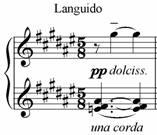
Example 17
This chord expands into a whole-tone introduction which, in turn, gains momentum and grows into a diatonic 'first subject'. Scriabin amplified this principle himself, appending the following lines to this Fifth Sonata:
I summon you to life, secret yearnings,
You who have been drowned in the dark depths,
Of the creative spirit, you timorous
Embryos of life, it is to you that I bring daring.24
Returning to the Fourth Sonata we hear the initial womb-like chord, the B 'major 7th' discussed earlier. The third of this chord is missing in the first moments however, and the emasculated chord lacks the distinguishing feature of major and minor. On the fourth beat the pitch is presented in a registrally displaced form, thus giving birth to the separation which is to become the main discourse of the music. The third of the chord becomes the beginning of the rising fourths – D#.
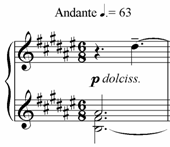
Example 18
This D# is the 6th of the F# major scale and becomes vitally important. The second movement of the sonata is famously associated with the concept of 'flight' and one can hear many obvious musical analogies to flying: sequentially ascending tremolo patterns, broken rhythms, small motives being hurled around the upper register, and the Left hand's frequent pedal points become centres of gravity. There are more subtle means of achieving this sense of flight which are beyond the scope of the paper but one we will mention briefly is the fact that throughout the entire sonata, those with a Schenkerian viewpoint find it difficult to build an Urlinie into the piece, principally because the 5 (C#) is constantly being displaced by the 6 (D#).25 This insistence on 6 again probably stems from Scriabin's reading of Tristan and Isolde, particularly Isolde's love-death as her soul ascends through the air to a climactic E major chord with a suspended sixth (C#) moving downwards to a B major chord with a similar suspension (G#). These sixths beautifully soar above Isolde's vocal line.

Example 19
The 6 was born in the opening of the Fourth Sonata and as we shall see, is only extinguished in the final bars. From creation – the birth of polarities, Scriabin leads us to their ultimate destruction – "dematerialization" and "synthesis". Approaching the end of the sonata we hear a final reminder of the irreconcilable D# (6) versus C# (5) conflict before an apotheosised rendition of the opening movement, in which the two gendered voices are fused into fistfuls of repeated chords – the same chords in octaves.
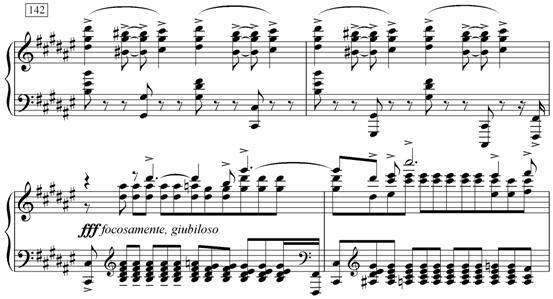
Example 20
The D# (6) becomes naturalized and chromatically falls to a C# (5) at the moment when we hear the first pure F# triad; the final chromatic seduction has been overcome.

Example 21
Thus all polarities become dissolved into a presentation of the theme from the Andante and ultimately into a grandiose exposition of the tonic chord, the same chord which has been implied many times but has remained abstract.
Wagner achieved this pattern of tonic avoidance over four hours and cleverly manipulates his material after the final climax of Tristan to end the opera as beautifully as it began, thoroughly enjoying a tonic chord of B major. Scriabin gives the tonic only as the very final gesture, perhaps somewhat crudely. He seems to have seen the tonic chord as the driving force behind his music, and so skilful is this avoidance of the chord that when it does arrive, it can sound almost disappointing and trite. Even as late as Prometheus, op.60, Scriabin still ended on a massively orchestrated tonic chord despite the fact that the work is debatably atonal. Could the modern listener then be justified in siding with Adorno in viewing 'out of context' tonic chords as "impotent clichés" which "no longer fulfill their function"?26 It is probably not unreasonable of Scriabin to give the public audience what he had been teasing them with for seven minutes, what they wanted to hear – an ecstatic tonic chord in which all differences disappear – what Susan McClary referred to, drawing on the language of pornography, as "the money shot".27 But what listeners tend to like in Scriabin's music is the flirtation with the tonic and the generation of tension through its absence. Perhaps as Pascal claimed, man simply prefers the hunt to the capture.28
1 A version of this paper was first presented at the RMA Research Students' Conference in Durham, 30 March–01 April 2005 Back
2 This paper is written within the context of a relatively new trend in musicology that has focused on issues of gender and sexuality. Initially influenced by the feminist movement in the 1980's, writers such as Catherine Clément, Ruth Solie, Marcia Citron, Susan McClary, Suzanne Cusick, Fred Maus, Lawrence Kramer, Mary Ann Smart and Stephen Downes among many others, have examined both the cultural context of musical composition and the musical discourse within the compositions themselves. Writers have tended to focus on the genres of opera, lied and programme-music, using the extra-musical dimension as a mediator between broad sociological issues and minute details of musical composition. Scriabin's Fourth Sonata is ideal material to examine because his own poetry, despite being purely private, reflects his broader philosophical perspectives and simultaneously helps to elucidate the technical processes of his musical logic. As part of a larger project, this brief paper highlights issues which I will explore more fully in Scriabin's piano and orchestral literature, and hopefully the models of gender-construction which can be found in this private programme-music may be useful in defining procedures in his 'absolute' compositions. Analyses of Scriabin's music have continued to appear since his death in 1915. My own gendered readings of the music are a preliminary attempt to explain the compositions in view of Scriabin's mystical-erotic preoccupations. Back
3 Faubion Bowers, Scriabin: A Biography, i, 2nd ed. (New York: Dover Publications, Inc., 1996), pp. 332–3 Back
4 Boris de Schloezer, Scriabin: Artist and Mystic, trans. Nicolas Slonimsky, (Oxford: Oxford University Press, 1987), p. 113 Back
5 H. P. Blavatsky, The Secret Doctrine: the Synthesis of Science, Religion, and Philosophy (London: The Theosophical Publishing Company Ltd., 1888). Scriabin obtained a Russian translation of this book and integrated many of its concepts into his own 'philosophy'. Back
6 Bowers, Scriabin, ii, p. 54 Back
7 It appears that Scriabin genuinely believed that he could achieve flight. He apparently tried to convince Georgy Plekhanov that "There are no obstacles to manifesting our wills. The law of gravity does not exist. I can throw myself from this bridge and I will not crack my head on the stones. I will float in the air. Thanks to will power." Bowers, Scriabin, ii, p. 96Back
8 Quotations from the Fourth Sonata are taken from the Dover edition of Scriabin's Complete Piano Sonatas, (New York: Dover Publications, Inc.) Back
9 Susan McClary, Feminine Endings: Music, Gender and Sexuality (University of Minnesota Press, 1991), pp. 57–58Back
10 Musical quotations of Wagner throughout this paper are taken from Indiana University's collection of online opera scores, located at http://www.dlib.indiana.edu/variations/scores/scores.html Back
11 Ellon DeGrief Carpenter, Thematic Development & Continuity in the 10 Piano Sonatas of Scriabin (diss., Kent State University, 1972), p. 56ff Back
12 Quoted from Scriabin 'Poem of ecstasy' and 'Prometheus: Poem of Fire in Full Score', (New York: Dover Publications, Inc. 1995). This version of the motive occurs shortly after fig. 15, p.51 Back
13 Stephen Downes, Szymanowski, Eroticism and the Voices of Mythology, (Ashgate: RMA, 2003), p. 24 Back
14 Wilhelm Reich, The Function of the Orgasm, trans. Vincent R. Carfagno, (London: Souvenir Press Ltd., 1993), p. 55Back
15 Bowers, Scriabin, i, p. 188 Back
16 Bowers, Scriabin, ii, p. 58 Back
17 The Mysterium was Scriabin's much discussed festival of music, dancing, colours, sounds and smells, which would bring an end to the world. The project was interrupted by the composer's untimely death in 1915 Back
18 Bowers, Scriabin, i, p. 226 Back
19 Arthur Schopenhauer, The World as Will and Idea: Abridged in One Volume, ed. David Berman, trans. Jill Berman (London: Everyman, J. M. Dent, 1995), p. 209 Back
20 Alfred J. Swan, Scriabin (London: John Lane: The Bodley Head Ltd., 1923), p. 76 Back
21 Bowers, Scriabin, i, p. 331 Back
22 Michel Foucault, The History of Sexuality: An Introduction, trans. Robert Hurley (New York: Vintage Books, 1990), p. 95 Back
23 Marcia J. Citron, Gender and the Musical Canon (Cambridge University Press, 1993), p. 44ff Back
24 Scriabin, Complete Piano Sonatas (New York: Dover Publications, Inc.). The quotation is from Scriabin's own Poem of Ecstasy Back
25 For an example of attempts to apply Schenkerian analytical methods to Scriabin's 'transitional' works, see James Baker, The Music of Alexander Scriabin (New Haven, CT: Yale University Press, 1986). For his discussion of the Fourth Sonata, see p. 194–201 Back
26 Theodor W. Adorno, Philosophy of Modern Music, trans. Anne G. Mitchell and Wesley V. Bloomster (London: Sheed & Ward, 1948), p. 38 Back
27 McClary, Feminine Endings, p. 113.Back
28 Pascal, Penseés, (Harmondsworth, Middlesex: Penguin Books Ltd., 1966), p. 68Back
© Kenneth Smith, 2005